Whenever Danny Jansen or Reese McGuire throws down the slider sign, Thomas Hatch has a decision to make. See, he doesn’t throw just one. There’s a bigger, slower slider he’ll throw with more depth when he wants a swing-and-miss, like this one to Ronald Acuna Jr.:

And then there’s a tighter, firmer slider he’ll use in the zone to try to get weak contact or called strikes, like this one to Renato Nunez that might as well be called a cutter:
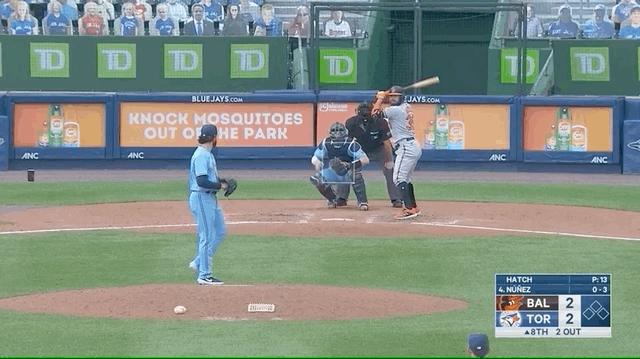
Whichever Hatch chooses, the catchers just have to be ready for it. And they get plenty of practice, as it seems every Toronto Blue Jays starter-turned-reliever has adopted a similar two-slider method.
Jordan Romano will throw his slider anywhere from 86 to 93 mph with its movement fluctuating in turn. Ryan Borucki is now calling his slider a cutter, although he’ll still occasionally throw it in extremely slider-ish fashion at 83 mph with plenty of break. And Sean Reid-Foley returned to the majors recently doing the same thing, ranging from 86 to 90 mph with his slider, which was an 83-84 mph pitch with more action when he was starting games in prior seasons.
It’s not a coincidence. The Blue Jays are encouraging their converted starters to manipulate how they throw their breaking balls now that they’re in bullpen roles, essentially turning one pitch into two. Want to go right after a hitter in the zone? Throw it harder and tighter. Want to try to get a swing-and-miss off the plate? Take a little bit off and throw it with more break.
“It depends on the individual and the shape of their pitches — what their fastball does and what their slider does, where we can enhance it and make it better,” Blue Jays pitching coach Pete Walker says. “It’s a process with certain guys — finding out what works for them and what works best with their fastball.”
Which brings us to Hatch. Because while he’s following the organizational trend with his slider, he has rarely needed it in his debut MLB season. His fastball has been too effective.
Through his first 18 2/3 big-league innings, Hatch has given up only three hits — two singles and a homer — off his mid-90s heater, which he’s been ramping up to 98 mph and throwing half the time. “Quietly electric,” as Walker put it during spring training, Hatch has ridden that fastball to a 1.45 ERA over his first 11 MLB appearances.
Now, to be fair, a few of his fastballs have been stung right at defenders, which is why his expected batting average allowed on the pitch — .214 — stands in stark contrast to his actual batting average allowed of .094. But the other thing that stands out about it is how often Hatch gets swings-and-misses with it, particularly when he throws it in the zone.
Hatch’s 30.8 per cent whiff rate with the pitch — and 32.8 per cent whiff rate overall — puts him in the top 15 per cent of MLB pitchers, and second on the Blue Jays behind only Jordan Romano. A sinker-slider guy in college, who then developed a sharp, splitter-like changeup that helped him make a name for himself in the minors, Hatch has materialized in the majors with a four-seam fastball that opposing hitters can’t figure out.
“I just try to be aggressive with it,” Hatch says. “Bullpen guy, stuff ticks up — you just trust your stuff and stay in the zone. Because walks kill you. I feel really confident about the way it plays. And the way it plays off of my other pitches, as well.”
Sure, but a lot of guys throw hard four-seamers out of a lot of bullpens. League average fastball velocity for relievers this season is 94 mph. So, what’s Hatch’s secret? It’s how tightly he spins it. Hatch’s average of 2,600 revolutions per minute puts him among MLB’s top-10 fastball spinners this season.

It’s a trait the Blue Jays clearly value. Jason Adam, who’s third on that list, spent 2019 in the Blue Jays organization and made 23 big-league appearances for the club. Robbie Ray, who Toronto traded for last week, is among the top 15 per cent of MLB fastball spinners this season. Joey Murray, a 23-year-old prospect who led the Blue Jays organization in strikeouts last year, spins it as well as any of them.
For his part, Hatch didn’t even know he possessed above-average spin until after his first year as a professional in the Chicago Cubs organization. Hatch was still throwing a sinker at the time, which doesn’t make as much use of the spin as a four-seamer does. So, Hatch changed his fastball grip on the fly, and, after some initial struggles, started getting a feel for it. Once he was traded to the Blue Jays last summer, things really took off.
“It's going from one extreme to the other — sinking the ball to four-seamers. You’re almost trying to become a completely different pitcher,” Hatch says. “And the Blue Jays have really explained the tendencies and what I need to do with that four-seam to be successful — that really helped.”
Four-seam fastball spin does a few interesting things. For starters, it disguises the baseball’s seams, making the pitch’s trajectory more difficult to track from the batter’s box. For hitters, it’s like trying to pick up a cue ball.
It also helps the ball fight gravity, causing it to drop less than hitters are accustomed to. No pitch in the history of baseball has ever literally risen as its approached the plate. But high-spin fastballs create the illusion of rising, which is why they can generate so many foul balls or outright whiffs from hitters who think it will come in lower than it does.
Here’s a good example. This full-count fastball is all over the plate, but Red Sox infielder Jose Peraza swings right underneath it:
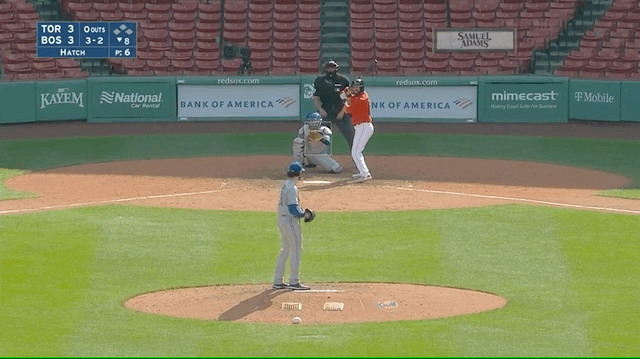
Here’s another heater right in Christian Vazquez’s happy zone that the Red Sox catcher can only get a piece of with the top of his barrel:
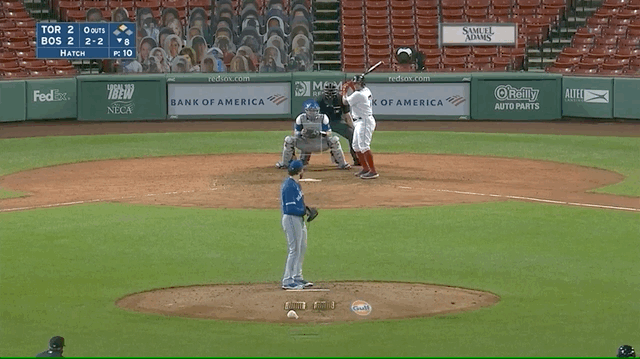
And one more, this time down in the zone, that Rio Ruiz obviously thought would drop even further:
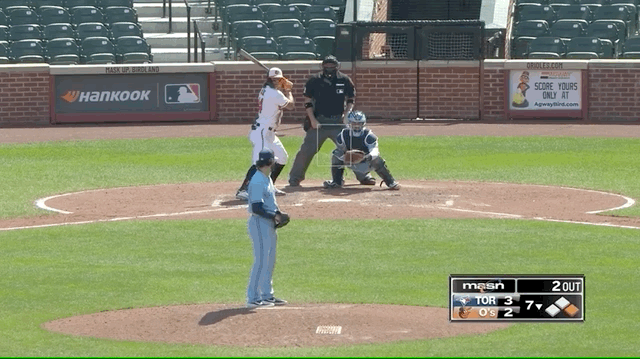
Just look at where Peraza, Vazquez and Ruiz’s swing planes are versus where Hatch’s fastballs ended up:
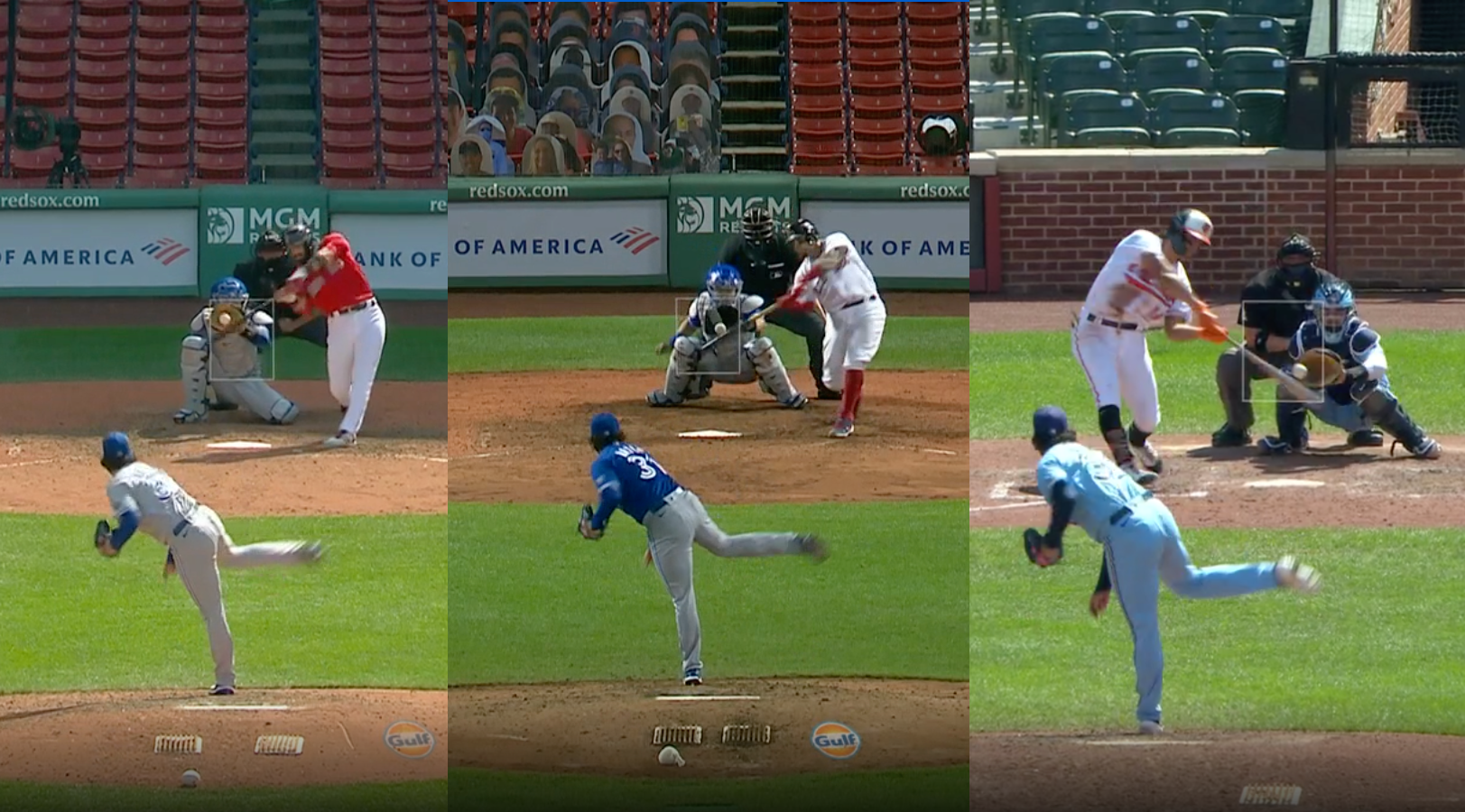
It just doesn’t drop as much as you think it will. And, when it’s 96, that’s all it takes. Move the ball off the barrel of the bat just a bit and you’ll get plenty of foul balls and plenty of weak contact that major-league defences will vacuum up. And in Hatch’s case, plenty of swings-and-misses, too. It essentially allows him to get away with pitches on the plate that other pitchers might call mistakes.
And that has carried over into his mentality and approach on the mound. As a minor-league starter, Hatch tried to be as fine as possible with his fastball command, aiming for the edges of the strike zone and neglecting the pitch when he got to two strikes. But now, as a major-league reliever with a couple of extra ticks of velocity behind his stuff, Hatch aims to catch more of the plate, and has thrown a fastball in more than half of his two-strike counts.
“Sometimes I can catch myself fading back toward being a little bit too fine,” he says. “But I feel like I have the command to, in two strike counts, go to fastballs and be effective with them. When somebody tells you that you have elite qualities of things, it gives you confidence in that pitch in moments that it wouldn't necessarily be a pitch to go to.”
That elite quality is the spin, and trusting it with two strikes has helped Hatch enjoy a stellar MLB debut. It’s one of a million adjustments you make going from the rotation to the bullpen. You’re throwing each pitch with more effort and facing each batter only once — so you trust your stuff and go right after them. The last thing you want to do is walk somebody while protecting a slim lead in late innings.
The next challenge will be reversing those adjustments if and when Hatch resumes pitching as a starter in seasons to come. He still has the changeup that got him to the majors. Plus the slider-cutter combo that every Blue Jays starter-turned-reliever seems to be throwing these days. He’ll have to throw them more often, adapting back to the rhythms of a starting pitcher who has to give the same hitters two or three different looks. But, then again, adapting on the fly is what Hatch has been doing his entire career.
“I think, ultimately, with my repertoire and the way that I pitch, I can hold that role as a starter,” Hatch says. “But baseball is a tough game. Especially to think into the future. So, I like to stay in the moment and know that I have one, two, maybe three innings this year. And I'm ready to help my team in that way right now.”

